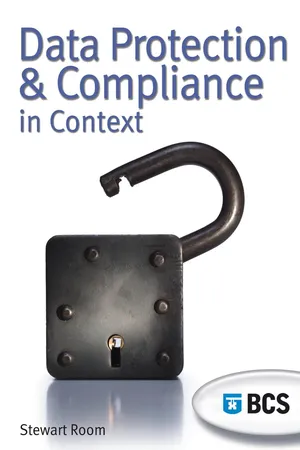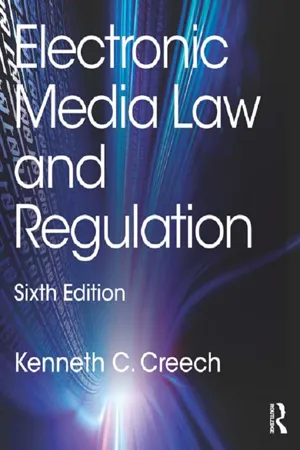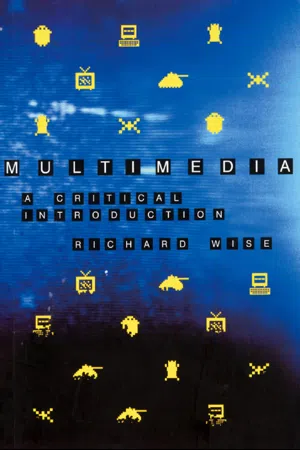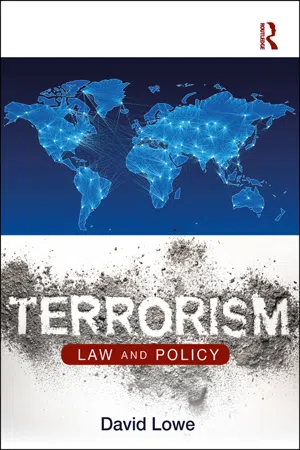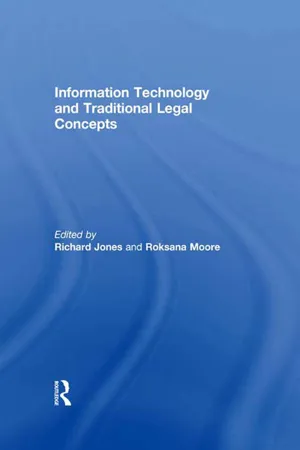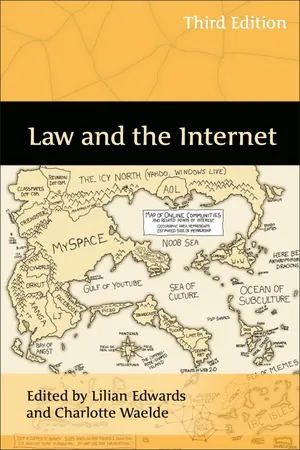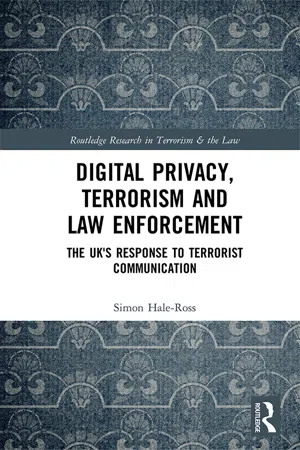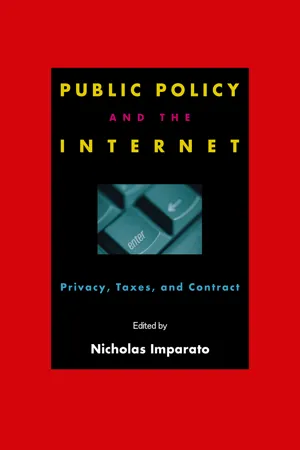Law
Privacy and electronic communications regulations
Privacy and electronic communications regulations refer to laws that govern the protection of personal data and privacy in electronic communications. These regulations typically cover issues such as consent for electronic marketing, confidentiality of communications, and the use of cookies and similar tracking technologies. They aim to safeguard individuals' privacy rights in the digital environment and ensure that their personal data is handled responsibly.
Written by Perlego with AI-assistance
Related key terms
9 Key excerpts on "Privacy and electronic communications regulations"
- eBook - ePub
- Stewart Room(Author)
- 2006(Publication Date)
- British Computer Society(Publisher)
6 Privacy and Electronic Communications INTRODUCTION The right to respect for privacy in communications is afforded legal protection by Article 8 of the ECHR, which identifies a right to respect for correspondence. For these purposes correspondence and communications are synonymous. In 1997 the EC introduced a specialized Directive on telecommunications privacy, 152 which complemented and built upon the protections within the Data Protection Directive. The object and scope of this Directive was described in Article 1.1 - eBook - ePub
- Kenneth C. Creech(Author)
- 2013(Publication Date)
- Routledge(Publisher)
Also of concern is the protection from surveillance by government, social networks, and other components of society. Advances in technology have allowed myriad users access to information about individuals. Organizations ranging from businesses and social media sites to law- enforcement agencies can easily retrieve information about a person's finances, legal and medical history, arrest records, sites visited on the Internet and recent purchases, to name a few. Needless to say, many people are concerned about who is granted access to such information, how it can be used, and for what purposes. While social media is governed by the agreement between the user and the site, the Federal Privacy Act of 1974 was passed to address matters involving government. The Privacy Act defines how individuals are protected from government invasions of privacy and is discussed later in this chapter. The Electronic Communications Privacy Act of 1986 provides additional protection for electronic transmissions from third- party monitoring and interference. The climate surrounding the World Trade Center attack in 2001 resulted in an erosion of the level of personal protection provided from government surveillance. Passage and renewal of the Patriot Act in 2001 and 2006 gave the federal government broad powers in seeking information about individuals that might link them to terrorist activities. Revelations in 2006 that personal telephone records of individuals not necessarily suspected of terrorist ties were made available to government agencies further eroded personal privacy protection from government.Protection from privacy invasions by individuals and the news media developed in a way quite different from that of protection from government snooping.THE DEVELOPMENT OF PRIVACY LAW
Privacy law is a relative newcomer to the American legal systemWhile the concept of libel has its roots in English common law of the Middle Ages, the law of privacy is a nineteenth-century American development. Before 1890, no American court had recognized a right of privacy. One hundred years later, some right of privacy was recognized in almost all jurisdictions. To this day, the extent of our personal rights of privacy are not clearly delineated and remain somewhat controversial. In fact, despite our general concerns over potential privacy invasions, many of us willingly surrender personal information to social-media sites, retail rewards programs, and other media that have become a part of our daily routine. In this chapter, however, we will address the unwilling surrender of personal privacy associated with interactions involving the news media, the Internet and government. - eBook - ePub
Multimedia
A Critical Introduction
- Richard Wise(Author)
- 2005(Publication Date)
- Routledge(Publisher)
While governments have always monitored their citizens for political and law enforcement purposes, and commercial organisations have always collected information about potential customers for marketing purposes, the tools available to both invade and protect privacy have increased in power and sophistication. In an escalating ‘arms race’ governments have attempted to regulate the use of privacy tools while individuals, political groups and civil liberties campaigners have sought to defend and enhance the privacy of the individual.Privacy tools
It’s personal. It’s private. And it’s no one’s business but yours. You may be planning a political campaign, discussing your taxes, or having an illicit affair. Or you may be doing something that you feel shouldn’t be illegal, but is. Whatever it is, you don’t want your private electronic mail (e-mail) or confidential documents read by anyone else. There’s nothing wrong with asserting your privacy. Privacy is as apple-pie as the Constitution.9Some encryption products put at risk efforts by federal, state and local law enforcement agencies to obtain the contents of intercepted communications by precluding real-time decryption. Real-time decryption is often essential so that law enforcement can rapidly respond to criminal activity and, in many instances, prevent serious and life-threatening criminal acts.10As these two quotes demonstrate, the availability of cryptographic tools has been the subject of fierce debate, particularly in the US. The question of who should be able to use these tools is of major importance because the power of modern encryption techniques allows communications in almost complete privacy.Whilst cryptography is often discussed in terms of one-to-one personal communication and the right to privacy, it is also the underlying technology for on-line financial transactions. This involves the secure transmission of credit card details, but increasingly supports other features such as authentication (‘digital signatures’) and digital cash transactions. Authentication allows the origin of messages and transactions to be verified. Digital cash allows on-line purchases to be made anonymously, like real cash but unlike credit-card purchases. This means that there are powerful commercial reasons for using cryptography as well as reasons associated with civil liberties issues. Indeed, commercial pressure is more likely to persuade governments to permit strong encryption than any argument based on a citizen’s right to privacy. - Robust safeguards ensure that the practices of the intelligence services and police are legally proportionate. These safeguards also ensure these agencies operate within the rule of law and allow for transparency of those agencies’ operations. This transparency is necessary in relation to accountability regarding the decision-making process when granting authorities and if there is any misuse of powers by state officials. 46 Categories of electronic communications data that are subject to wider surveillance The electronic communications data that has been subject in many states’ recent and proposed legis lation to the granting of further powers of surveillance includes communication data that gives details of the time, duration, originator and recipient of communication. In common parlance, this is ‘the who, when and where of communication, but not the content of the communication itself’. 47 Breaking it down into three distinct categories, communications data includes: Traffic data – this is where communications is or may be transmitted through a telecommunications system that identifies a person, the apparatus used or the location to and from which the communication is made. It can identify or select the apparatus by which the communication is transmitted. Traffic data comprises of signals for the actuation of the apparatus used for the purposes of a telecommunications system to effect the transmission of the communication. It also can identify the time at which the communication occurs or can identify the data contained in or associated with the communication. Use data – this relates to the actual information related to the use made by the person of a telecommunications service or in connection with the provision or use by a person of a telecommunications system, but does not contain the contents of any communication
- Richard Jones, Roksana Moore(Authors)
- 2013(Publication Date)
- Routledge(Publisher)
Is it possible to define ‘privacies’ within the law? Reflections on the ‘securitisation’ debate and the interception of communications Dan Ritchie University of Cumbria, Carlisle, UKThis article originates from the author’s ongoing research into whether common factors that define ‘privacy’ may be identified and theorised. The research focuses on privacy in relation to the interception of communications. The rapid development over the past three decades of new technologies of surveillance raises a number of important questions about what is perceived as the shifting relationship between the citizen and the state. With the Information Commissioner and others to claim that modern British society is a ‘surveillance society’, and that the privacy of citizens is being sacrificed on the altar of ‘security’. However, it is not the case that a commonly accepted definition of privacy exists. The paper outlines the methodology to identify the contingents that are present in debates over privacy. First, it considers the difficulties in trying to define privacy since Warren and Brandeis’, ‘The Right to Privacy’, essay famous, and argues that the term ‘privacy’ does not convey a purposeful meaning in terms of the interception of communications. Second, it identifies factors which allow privacy to be understood as a form of personal power. These factors point not only to whether information itself should be private to an individual but to the contexts in which the information is obtained. It is not information per se that is the key factor but its context. Finally, it is argued that it may be possible to isolate the factors that will produce a definition of privacy in relation to the interception of communications by looking at each set of circumstances and asking certain key questions.Introduction
Many sites of social life are being reconfigured by new technologies of identification, monitoring, tracking, data analysis and control. We have seen the rapid growth of computerised databases for the purposes of gathering, storing and processing intelligence to be used by law-enforcement agencies, databases that have ‘developed in the UK largely unnoticed’ and without any significant public debate.1 We have also witnessed the rapid development and use of biometric identification technologies in both daily life – witness the biometric fingerprinting of children in schools for example – and in the criminal justice system.2 Add to these developments the blurring or decline of distinctions between external and internal security, policing and soldiering, and war and crime,3 leading to the creation of international databases storing information on just about all aspects of individuals’ movements, justified in the name of security, and it is argued that currently virtually all forms of policy are developed to facilitate governance through securitisation, a process in which ‘an issue is framed as a security problem’.4 Drawing so many individuals into the surveillance field is considered to be a dangerous reassertion and extension of state powers.5 Bigo, for example, claims that ‘Security is, conceptually, reduced to technologies of surveillance, extraction of information, coercion, acting against societal and state vulnerabilities, in brief to a kind of generalized “survival” against threats coming from different sectors, but security is disconnected from human, legal and social guarantees’.6- eBook - ePub
- Lilian Edwards, Charlotte Waelde, Lilian Edwards, Charlotte Waelde(Authors)
- 2009(Publication Date)
- Hart Publishing(Publisher)
Like telephone metering data in previous decades, it is also covered by the definition of ‘private life’ 13 contained in Article 8 of the European Convention on Human Rights (ECHR). To fully understand the extent to which the use of communications data can affect an individual’s right under Article 8 ECHR, a distinction must be made between the conditions under which such data can or must be retained and the grounds on which it can be accessed. III. RETENTION OF COMMUNICATIONS DATA A. Voluntary Retention of Communications Data At the European level, the DPD requires Member States to ensure that data controllers only collect personal data for specified, explicit and legitimate purposes and do not further process this in a way incompatible with those purposes. 14 Under Article 6(1)(d), data controllers must also take every reasonable step to ensure that data which is inaccurate or incomplete is erased or rectified. In addition, the Privacy in Electronic Communications Directive (PECD) 15 requires Member States to ensure the confidentiality of communications and related traffic data in public telecommunications networks and publicly available electronic communication services. 16 It also stipulates that CSPs must erase or make anonymous any traffic or billing data they generated upon termination of the communication in question, unless they require such data for their own billing or marketing purposes (the latter use being subject to the subscriber’s consent). 17 CSPs which continue to retain communications data beyond the requisite period are likely to face civil and criminal liability - eBook - ePub
Digital Privacy, Terrorism and Law Enforcement
The UK's Response to Terrorist Communication
- Simon Hale-Ross(Author)
- 2018(Publication Date)
- Routledge(Publisher)
This is particularly relevant to the issues raised in Chapters 2, 3 and 4 combined, where the use of Internet and email raises problems when private or public organisations wish to monitor its use. Briefly, an organisation has a right, even a duty, to monitor the use of the Internet and emails to prevent them being used for unlawful purposes or to distribute offensive material. However, running concurrent to this obligation is the fact an individual has a right to data privacy and protection. It is the duty of all organisation to provide access to email and the Internet to balance these two conflicting principles. In specific policing terms section 29 of DPA deals with crime and taxation exemptions that permit personal data to be processed and withheld from the individual concerned for the purposes of the prevention or detection of crime. Such exemption must be proportionate, and the ‘data controller’ must record the data being processed. This means of course that a person may not be able to ascertain what information law enforcement has collected.Key human rights instruments: influencing the UK’s approach
The right to data privacy is enshrined in the EU at the constitutional level through Article 8 of the Charter of Fundamental Rights (CFR or Charter) and at the legislative level by way of two directives, namely the Data Protection Directive in 1995 and the e-Privacy Directive in 2002.5 In the interests of fullness, the 2002 Directive repealed the earlier 1997 version aimed primarily at the telecommunications sector, so it is no longer relevant.6EU constitutional protection: the Treaty of Lisbon
As a result of the ratification of the Treaty of Lisbon 2007, which came into effect in 2009, the Charter of Fundamental Rights 2000 was given legal status. Therefore, constitutionally speaking, data privacy and protection is afforded by Article 8 of the Charter which states individuals have a right to the protection of personal data:Such data must be processed fairly for specified purposes and on the basis of the consent of the person concerned or some other legitimate basis laid down by law. Everyone has the right of access to data, which has been collected concerning him or her, and the right to have it rectified. - eBook - ePub
Public Policy and the Internet
Privacy, Taxes, and Contract
- Nicholas Imparato(Author)
- 2013(Publication Date)
- Hoover Institution Press(Publisher)
Mary J. Cronin1
Privacy and Electronic Commerce
E very opinion and lifestyle variant known to humankind has found a home somewhere on the Internet, so it should come as no surprise that the global network has also spawned diverse and deeply held positions on the subject of on-line privacy. It might seem that the very nature of the net, with its open participation and millions of entry points around the globe, runs counter to many traditional notions about privacy. But labeling “Internet privacy” an oxymoron is not likely to end the debate. The explosion of web sites actively collecting, mining, and sharing information about individual Internet users has prompted a serious policy division between those countries (notably the United States) that support self-regulation of Internet privacy practices and those that have enacted government measures to protect personal data. Privacy has also emerged as a touchstone for consumer concerns about the Internet, fueled by media revelations of behind-the-scenes web data collection practices.This chapter discusses the major issues that have emerged in the debate over on-line privacy, with a particular focus on the differences between the regulatory outlook in the United States and that in the European Union. It raises three related policy questions:- Is the appropriate balance between privacy and information disclosure best negotiated between the individual users and the web sites they choose to visit or is some type of regulation or external review required to improve current privacy practices?
- Does the U.S. reliance on corporate self-regulation put it on a collision course with the European Union and other regions that have opted for government-enforced privacy protection standards?
- eBook - ePub
- Amitai Etzioni(Author)
- 2014(Publication Date)
- Polity(Publisher)
However, the Electronic Communications Privacy Act of 1986 extended the full intercept laws to apply to electronic communications. 26 Email messages differ from phone conversations in important ways that have made the old laws, at best, an imperfect fit. 27 Emails do not travel over phone lines in discrete units that can just be plucked out. They are broken up into digital packets and travel over the internet through different routes and mixed together with the packets of the messages of other users. This creates a challenge for law enforcement agents attempting to intercept or trace the email of just one user without violating the privacy of other users. 28 Problems also occurred when agents received the same search warrants to obtain saved email that they would use in any other physical search. Under old laws, a warrant must be obtained from a judge in the jurisdiction where the search will take place. 29 Email, however, is not always stored on a personal computer, but often is stored remotely on the servers of internet service providers (ISPs). This means that if a suspect, say, in New Jersey had email stored on a server located in, say, Silicon Valley, an agent would have to travel across the country to get a warrant to seize the email. 30 In short, the introduction of both cellular phones and email created new challenges to the ability of public authorities to conduct communications intercepts, even if they were fully authorized by a court – intercepts that had been an important tool of law enforcement. Another technological development has made communications intercepts much more difficult still. Before it is introduced, a brief digression
Index pages curate the most relevant extracts from our library of academic textbooks. They’ve been created using an in-house natural language model (NLM), each adding context and meaning to key research topics.
